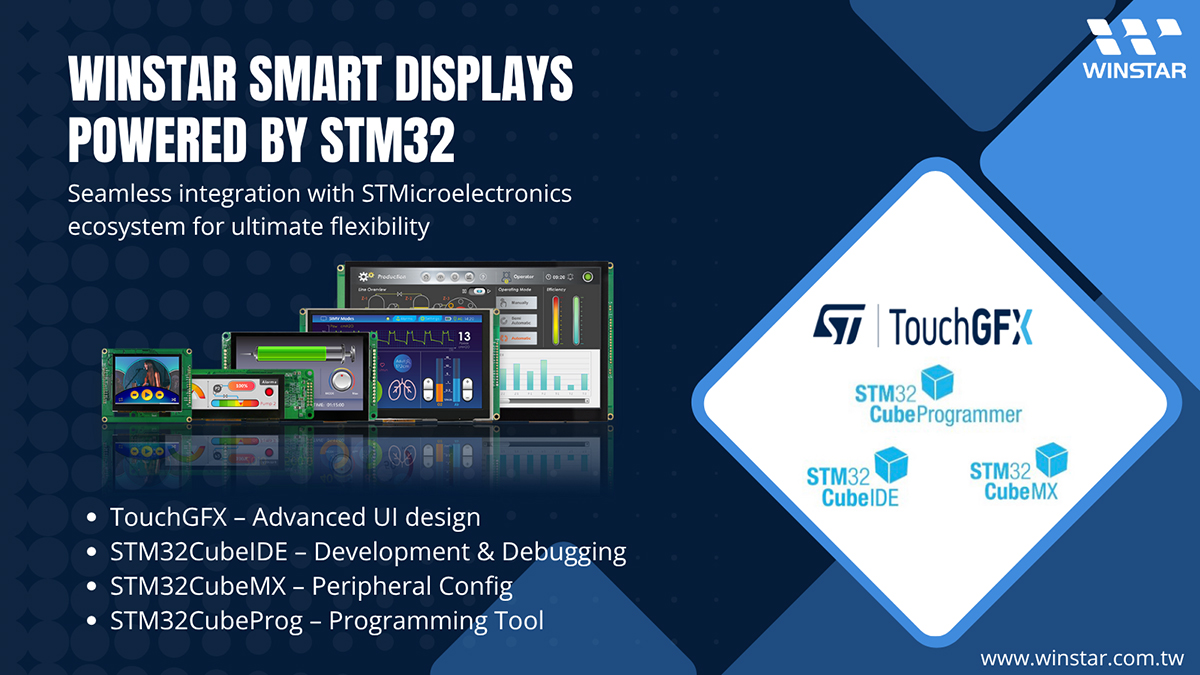Developing WINSTAR Smart Displays with STM32 Ecosystem & GUI Builder
WINSTAR Smart Display modules are built to simplify HMI (Human Machine Interface) development across industrial, medical, and commercial applications. Powered by STMicroelectronics' STM32 microcontrollers, our Smart Displays are fully compatible with TouchGFX, STM32CubeIDE, STM32CubeMX, and STM32CubeProg—giving developers a familiar and robust software environment.

In addition to ST's ecosystem, WINSTAR also offers a no-code GUI Builder tool, empowering engineers of all levels to rapidly prototype and deploy interface designs with ease.
Two Flexible Development Paths
WINSTAR Smart Displays support two development approaches:
1. Using GUI Builder – No Coding Required
Our proprietary GUI Builder tool is designed for fast and intuitive HMI development. It allows users to create interfaces using drag-and-drop widgets, set up page logic, and preview real-time display behavior without writing a single line of code.
- Intuitive UI design interface
- Real-time preview with simulation
- Multi-language text, image, animation, QR code, and meter support
- Faster time to market with minimal technical overhead
2. Developing with ST's Software Ecosystem
For developers already familiar with STM32, WINSTAR Smart Displays can be fully integrated into ST's native development environment. This path is ideal for users requiring advanced customization, performance tuning, or direct code control.
- TouchGFX – Create rich graphical interfaces optimized for STM32
- STM32CubeIDE – Comprehensive code development, debugging, and project management
- STM32CubeMX – Easy configuration of STM32 peripherals
- STM32CubeProg – Programming, flashing, and debugging STM32 MCUs
Communication Interface Options
WINSTAR offers Smart Displays with multiple communication protocols to suit different system architectures:
- CAN Bus Smart Displays
Support optional CANopen or CAN2.0 A/B protocols and seamlessly integrate into automotive and industrial networks.
➜ Explore CAN Smart Displays - RS485 Smart Displays
Built for long-distance twisted differential pair communication using Modbus RTU.
➜ Explore RS485 Smart Displays - UART Smart Displays
Ideal for simpler, point-to-point communication. Available in multiple sizes with versatile commands.
➜ Explore UART Smart Displays
STM32 at the Core – Built for Performance and Scalability
All WINSTAR Smart Display modules are equipped with STM32 series microcontrollers, offering high performance, power efficiency, and scalability across different display sizes and communication types. With these processors at the core, users can rely on long-term supply, strong documentation, and rich community support.
Application Examples
- Industrial control systems
- EV chargers
- Smart appliances
- Medical devices
- Energy management systems
Start Developing Today
Whether you're an experienced STM32 developer or a system integrator seeking a no-code solution, WINSTAR provides the flexibility to match your workflow. Leverage the power of STM32 and streamline your development with GUI Builder or ST's trusted toolchain.
Learn more about our Smart Display series
Contact us to discuss your project requirements.


